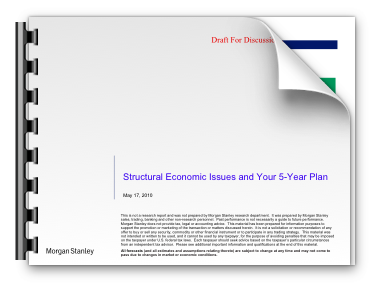 Entrepreneur and economist Toby Baxendale responds to warnings over errors in output gap data by explaining that there is no output gap, only lost capacity to produce goods no one can afford once cheap credit comes to an end.
Entrepreneur and economist Toby Baxendale responds to warnings over errors in output gap data by explaining that there is no output gap, only lost capacity to produce goods no one can afford once cheap credit comes to an end.
Via FT.com / FTfm / Columnists – Beware of errors in output gap data:
Massive fiscal deficits and unorthodox monetary policies have left many market participants worried that the Federal Reserve will unleash the inflation genie at some stage. Fed chairman Ben Bernanke insists that he is committed to price stability and has the means to achieve it. That may well be so. What’s less clear is whether Helicopter Ben, or anyone else at the Fed, will know exactly when to employ his anti-inflationary toolkit.
…
Rather, the Fed will likely remain passive until the economy is running near full capacity, or what economists call the “output gap” has narrowed. This sounds sensible. After all, inflation comes about when too much money chases too few goods and services, causing the economy to overheat.The trouble is that the track record of economists measuring the output gap in real time is rather patchy, to say the least.
In the Financial Times of August the 3rd, Edward Chancellor warns us we should not assume, just because we have high unemployment and idle capacity in factories, that we have spare capacity which can be employed before inflationary pressures start to work their way though the economy. Chancellor warns that economists’ track record of measuring the output gap is “rather patchy”. The conventional wisdom is that if we have idle resources, we must have spare capacity which will be employed without any price pressure on the economy when demand starts to rocket.
Conventional wisdom reasons further that one can create money out of thin air — “Quantitive Easing” or “Open Market Operations” by the central bank to stimulate demand — and that new money will not be inflationary, if the circumstances are right. The massive growth on central banks balance sheets that is potentially inflationary would be un-wound before any inflation emerged by placing bonds back in the market.
Thus the central banks around the world would manipulate the economy back to health like magic!
The writer views the conventional wisdom and urges caution, pointing to 1973, when all businesses had to cope with a 3 fold increase in the price of oil. He calls this a structural change “rendering much embedded capacity redundant and shifting the economy to a lower trend growth rate.” This was when the herd thought that the high unemployment of the time meant there was 10% spare capacity.
The reality was a period of “stagflation”: rising prices and rising unemployment. This was the single economic feature in whose coffin we thought we had put the final nail, crass Keynesianism.
Sadly, this latter train of thought is very much prevalent today. What commentators fail to realise is that if we have all been selling a portion of goods that have been demanded because people have had cheap credit, then, more than likely, what they want to buy with actual money is goods that they prioritise most importantly. Credit created money, or bubble activity, makes you purchase things further down your needs / wants scale of priority — further away from immediate needs / wants satisfaction. When creating cheap credit, as most of the central banks have done since the mid-90’s, you are creating a mismatch between that which is demanded on a sustainable basis and that which is not: that which is only demanded because it is supported by bubble activity.
As a business man with the largest privately held fresh fish company in the UK, I have never seen such a change in consumption patterns as people trade down to eat cheaper things. Extra capacity I have for sure. However, it is not conducive to production of the things that people do want, but of the things they do not want! The emphasis is on very keen value for money. As the economy picks up, I will have to invest in new ways of doing things to cope with the new pattern of demand. That “excess capacity” is lost: blown away by the winds of destruction post Lehman’s.
This is the problem with using the Keynesian demand and supply framework where capital is K, a homogeneous blob, and not the heterogeneous thing it really is. The former way of looking at things precludes an understanding of the detail that matters.
Production creates demand1, something economists have long known. Cheap credit makes businesses behave as if there are more savings to fulfil the seemingly unstoppable new demand. Even if you are weary about this, to stay competitive and retain your share of the market, you participate. When we realise the Emperor has no clothes and we are all happy to say so — the “Lehman’s moment” — the whole house of cards collapses: we realise that we have to restructure our supply to the new levels of demand.
There is no output gap. There is only the existing demand and supply framework for goods and services. Attempts to manipulate this by printing money to stimulate new demand will only lead to either:
- An absorption of all the productivity gains by giving not lower prices2 but stable or rising prices, or
- Just plain and simple rising prices.


